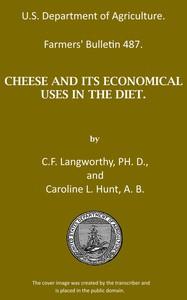|
|
Read this ebook for free! No credit card needed, absolutely nothing to pay.Words: 20291 in 9 pages
This is an ebook sharing website. You can read the uploaded ebooks for free here. No credit cards needed, nothing to pay. If you want to own a digital copy of the ebook, or want to read offline with your favorite ebook-reader, then you can choose to buy and download the ebook.

: Cheese and its economical uses in the diet by Hunt Caroline Louisa Langworthy C F Charles Ford - Cheese; Cooking (Cheese); Cookbooks@FreeBooksThu 08 Jun, 2023 w priced are important not only from the point of view of flavor, but also from the point of view of their nutritive value. Among such cheeses the one which, as noted above, is known to the trade as standard factory cheese and to the housewife as American cheese stands out pre-eminently. Therefore when the word "cheese" is used without specification in the following pages it may be taken to refer to this particular variety. THE FLAVOR OF CHEESE. Cheese owes its flavor to the fatty acids and their compounds which it contains and to ammonia-like bodies formed during ripening from the cleavage of the casein, to salt added to the curd, and in some varieties, like Roquefort, to bodies elaborated by molds which develop in the cheese. In the highly flavored sorts some of the fatty acids of a very marked odor are present in abundance, as are also the ammonia-like bodies. Indeed, in eating such cheese as Camembert a trace of ammonia flavor may often be plainly detected. The cleavage of the nitrogenous material of the cheese and other changes are brought about chiefly by the action of enzymes originally present in cheese or by microorganisms and are to be regarded as fermentative and not as putrefactive changes. The liking for highly flavored cheeses of strong odor is a matter of individual preference, but from the chemist's standpoint there is no reason for the statement often made that such cheeses have undergone putrefactive decomposition. COMPOSITION OF CHEESE AND SOME OTHER FOODS COMPARED. In the present state of our knowledge concerning dietetics it seems best to give the housekeeper general rather than absolute rules with respect to the kind and amount of food which should be eaten at any meal or at any given time by persons in normal health living under usual conditions. It is not necessary, therefore, for the housekeeper to know the exact composition of food materials in order to cater well for her family, a rough approximation being sufficient for the purpose. In the case of cheese she will be near enough to the fact if she thinks of it as composed approximately of equal parts by weight of proteids, fats, and water. This rough conception is sufficient to associate it in her mind with the foods of high proteid value, a point which is important in connection with the making of bills of fare. It should lead her to class it also with the foods which are rich in fat and prevent her from combining it unnecessarily with other fatty foods. In order, however, that the question of the use of cheese in the diet may be adequately discussed, knowledge of its composition in comparison with other foods is desirable, and there is an abundance of data available on this subject, since the composition of cheese and other foods has often been investigated at the Department of Agriculture, in experiment station laboratories, and in many other places where nutrition problems are studied. An extended summary of analyses of cheese of different sorts is included in an earlier publication of this department. Data regarding the composition of cheese and a few other common foods are summarized in the following table: It will be seen from the above table that cheese has nearly twice as much protein, weight for weight, as beef of average composition as purchased and that its fuel value is more than twice as great. It contains over 25 per cent more protein than the same weight of porterhouse steak as purchased, and nearly twice as much fat. As shown by the figures in the above table, cheese contains 3.8 per cent ash. Of this a considerable part may be salt added in cheese making. Like the milk from which it is made, cheese ash is characterized chiefly by the presence of calcium , magnesium, phosphorus, and iron, the average values as given in earlier bulletins of the department being 1.24 per cent calcium oxid, 0.049 per cent magnesium oxid, 1.49 per cent phosphorus pentoxid, and 0.0015 per cent iron. The total amount of the mineral matter needed per day by the body is relatively small, yet mineral matter is very important. It is commonly assumed and is probably true, that a mixed diet reasonably varied and reasonably generous will supply all the ash constituent which the body requires. If for any reason calcium and phosphorus are lacking in the diet, the amounts may be readily increased by a free use of milk and such milk products as cheese and junket, without decreasing the palatability of the diet or materially increasing its cost. Free books android app tbrJar TBR JAR Read Free books online gutenberg More posts by @FreeBooks
: A guide to Plymouth and its history by Briggs Helen T Briggs Rose T Dreher Raymond C Illustrator - Pilgrims (New Plymouth Colony); Plymouth (Mass.) Guidebooks; Plymouth (Mass.) History@FreeBooksThu 08 Jun, 2023

: Coloured engravings of heaths; vol. 2 by Andrews Henry Cranke Active - Ericas; Ericas Pictorial works@FreeBooksThu 08 Jun, 2023
|
Terms of Use Stock Market News! © gutenberg.org.in2025 All Rights reserved.






